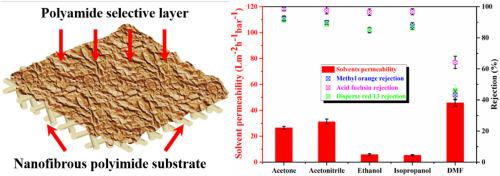Journal of Membrane Science ( IF 8.4 ) Pub Date : 2021-09-03 , DOI: 10.1016/j.memsci.2021.119825 Xiaofei You 1, 2 , Jeng Yi Chong 1 , Keng Siang Goh 1, 2 , Miao Tian 3 , Jia Wei Chew 1, 4 , Rong Wang 1, 5

|
Electrospun polymeric membranes are promising substrates for thin-film composite (TFC) membranes due to their unique interconnected pores and high porosity. However, it is still challenging to fabricate desirable electrospun substrates for organic solvent nanofiltration (OSN) owing to the relatively complex processing procedures and the organic operating environment. In this work, solvent-resistant electrospun polyimide (PI) nanofiber substrates were successfully fabricated through electrospinning followed by chemical cross-linking and heat-pressing. The cross-linking step improved the solvent tolerance of the membranes, while the heat-pressing step reduced the substrate pore size and surface roughness. However, it was found that heat-pressing at high temperatures (>140 °C) could degrade the cross-linking of PI, undermining their solvent-resistant property. A polyamide thin film layer was then synthesized on the solvent-resistant electrospun nanofibrous substrates via interfacial polymerization using reactant monomers m-phenylenediamine (MPD) and trimesoyl chloride (TMC). The TFC membranes exhibited excellent acetonitrile and acetone permeabilities of 31.28 ± 1.93 and 26.58 ± 1.13 L m−2 h−1 bar−1, respectively, with acid fuchsin (585 Da) and methyl orange (327 Da) rejections of 98.55 ± 1.24% and 92.42 ± 1.66%, respectively, in acetone. This study successfully demonstrated the potential use of electrospun PI nanofibers substrates for TFC membranes in OSN.
中文翻译:

用于有机溶剂纳滤的静电纺聚酰亚胺基薄膜复合膜
静电纺丝聚合物膜由于其独特的互连孔和高孔隙率而成为薄膜复合 (TFC) 膜的有前途的基材。然而,由于相对复杂的加工程序和有机操作环境,制造用于有机溶剂纳滤 (OSN) 的理想电纺基材仍然具有挑战性。在这项工作中,通过静电纺丝、化学交联和热压成功地制造了耐溶剂电纺聚酰亚胺 (PI) 纳米纤维基材。交联步骤提高了膜的溶剂耐受性,而热压步骤降低了基材孔径和表面粗糙度。然而,发现在高温(> 140 °C)下热压会降低 PI 的交联,破坏其耐溶剂性。然后使用反应单体通过界面聚合在耐溶剂电纺纳米纤维基材上合成聚酰胺薄膜层间苯二胺 (MPD) 和均苯三甲酰氯 (TMC)。TFC 膜表现出优异的乙腈和丙酮渗透率,分别为 31.28 ± 1.93 和 26.58 ± 1.13 L m -2 h -1 bar -1,酸性品红 (585 Da) 和甲基橙 (327 Da) 截留率为 98.55 ± 1.24%和 92.42 ± 1.66%,分别在丙酮中。该研究成功证明了电纺 PI 纳米纤维基材在 OSN 中用于 TFC 膜的潜在用途。











































 京公网安备 11010802027423号
京公网安备 11010802027423号